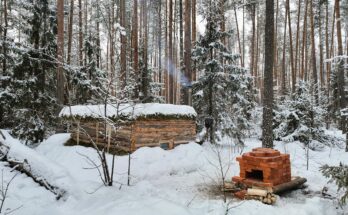BUSHCRAFT: BUILDING A LOG SHELTER FOR SURVIVAL — A HEAVY SNOWFALL CAUGHT ME OUT AT NIGHT!
The forest was quiet when I set out that morning, the air sharp with the promise of winter. I’d planned only a short hike to scout a new trapping line, but nature had other ideas. By late afternoon, a gray sky had thickened into a heavy ceiling of cloud, and before long, the first flakes of snow began to fall. What started as a gentle dusting quickly turned into a blizzard. The world dimmed, the trail disappeared, and I realized with a sinking heart that I wouldn’t be making it back to camp before nightfall.
In the wild, panic is your worst enemy. I took a deep breath and forced myself to think clearly. I needed shelter — fast. The temperature was dropping, and the snow was already piling around my boots. I found a stand of spruce trees on the leeward side of a small ridge. The thick boughs offered some protection from the wind and enough fallen timber to build with. Bushcraft isn’t about fighting nature; it’s about working with what’s around you. I took stock of my tools: a small axe, a knife, and a length of cord. It would have to be enough.
First, I cleared the ground down to the frozen earth, kicking away the snow until I had a space about two meters long. I laid a bed of spruce branches to insulate me from the cold ground — a crucial step, as contact with frozen soil can drain body heat frighteningly fast. Next came the frame. I found a sturdy fallen log to serve as the main ridgepole, propping one end against the crook of a standing tree and securing it with cord. Then I leaned shorter logs and thick branches along both sides, forming a rough A-frame structure.
The work was slow. My fingers were numb, and snow gathered on my shoulders and hair, but I kept moving. Each log I placed became part of my lifeline. Once the frame was solid, I began stacking smaller branches and layers of spruce boughs over the sides, weaving them together tightly. The trick is to create overlapping layers — a natural shingle effect that sheds snow and traps heat. I used handfuls of snow to seal the gaps, oddly enough. Packed snow acts as insulation, and in a storm like this, every bit helped.
When the last light faded, I crawled inside my rough log shelter. It wasn’t pretty, but it was solid. The wind howled outside, carrying the hiss of blowing snow, yet inside I could feel a pocket of still air. My breath steamed in the darkness. I built a small fire in a shallow pit just outside the entrance, careful to shield it with rocks so the sparks wouldn’t touch the shelter’s walls. The flickering glow cast long shadows through the gaps, turning my simple shelter into a cocoon of warmth and light.
I melted snow in my metal cup for water and chewed on a bit of jerky from my pack. The blizzard raged through the night, hammering the forest with a relentless rhythm. Occasionally I heard branches snap in the distance — reminders of the weight of snow pressing down. But my log shelter held firm. I’d chosen good timber, braced well, and trusted the old bushcraft lessons that had been passed down to me by mentors and experience alike.
By dawn, the storm had spent itself. I pushed open the entrance to a world transformed. The forest was silent under a thick white blanket, the air crisp and still. My shelter stood half-buried but intact, a testament to simple knowledge and steady hands. As I stretched stiff limbs and watched the sun break through the trees, I felt an immense gratitude — not just for survival, but for the reminder that even in the wildest conditions, preparation, patience, and respect for nature make all the difference.


